2016年 報告(2015年度プログラム)
2016年 海外短期フィールドワーク 児童発達学科 報告06-1
【2016年 海外短期フィールドワーク 児童発達学科 報告06-1】
■ Cabrillo College(アメリカ カリフォルニア州 サンタクルーズ) で、3/13〜3/28までの海外短期フィールドワークです。
■日付は、日本時間での表記です(現地は、1日前になります)。
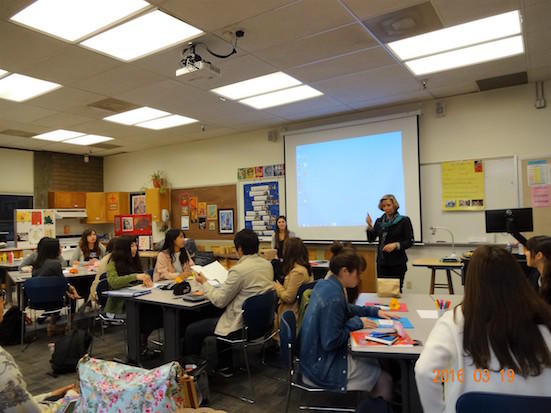
2016/03/19
今日は一週目の最後の日です。ジーンとメリサンドから、カブリヨ大学の幼児教育に関する基本的な考え方についての講義を受けました。事前の資料でもカブリヨ大学の基本概念(1.遊びの重要性、2.個々に沿って自主性を引き出すカリキュラム、3.親支援、4.問題・衝突の解決法、5.多様性)を勉強していることもあり、理解はできたのではないでしょうか。しかし、実際に具体的な話をたくさん盛り込んでの講義は、保育の専門家を目指す学生たちにとっては、さらに理解を深めるものになったことでしょう。とても有意義な話ばかりで、しかもたくさんあってここで全部は書ききれませんが、2つだけ紹介しておきます。(次に続く)
Jean and Melisande gave us a talk on Cabrillo College Early Childhood Education philosophy including a brief overview of the 5 main components; Play based curriculum, Individualized/Emergent curriculum, Child and family centered, Conflict resolution, and Pro-Diversity. To Bunkyo students, the lecture in English was a bit difficult but they seemed to understand the gist of the talk because Jean and Melisande kindly prepared for supporting materials for them such as slides with photos, handouts which had been delivered before they came here, and actual objects mentioned in the talk. They also spoke slowly with lots of great examples and fun episodes. On top of that, the topic about children and ECE is the best interest of the students, so they can easily imagine certain cases comparing with their Japanese counterparts.Among so many things they learned from this lecture, only two issues will be discussed here; one is the relationship between family members and teachers and the other is the idea of “open snack.” (continued to the next photo)
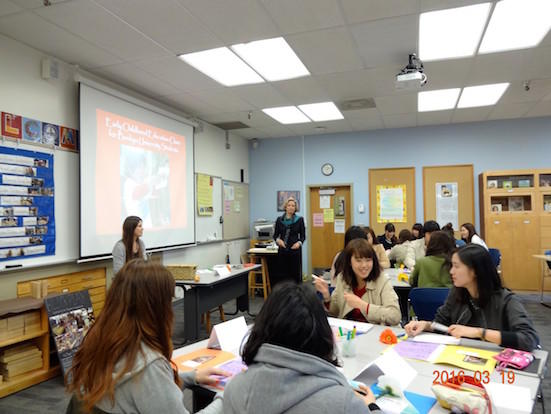
2016/03/19
(前のコメントからの続き)
例えば、3.親支援は日本でも重要項目にあがっています。「モンスターペアレント」と呼ばれる現象は、アメリカにもあると言っていましたね(英語では、helicopter parent=過干渉親 が近い言い方ですが、全く同じではありません)。そのような親に対する対応は様々でしょうが、たくさんいる親の中でそうなるのはほんの一部でもあります。そうなる理由の根底にあるのは、親の子を思う気持ちから出ていることを考えれば、その点で「子どものために」と思う教師側とも一致点があることがわかります。その親たちの考えを聞くことは、その親をもっと知る機会を提供してくれていることと肯定的に考えて、とにかく根気よく親と向き合って話し合うことしかないようですね。それから、「オープンスナック」の話もおもしろかったですね。これは、「おやつの時間」のことですが、一斉に食べるおやつではなくて、一定の時間内に食べたい人がやって来て食べるもので、先生が一人その時間中ついています。これの意図は、自分の体を自分で管理する練習だそうです。おなかがすいているかどうかを自分で判断し、食べたいか食べたくないかを決められる「自由なおやつタイム」ということですが、小さい子どもにとっては難しい判断でもあります。一斉にみんなで食べる昼食も楽しみな時間ですが、個々の意思決定が要求される機会がこの年齢から始まっていることもわかります。
(continued from the previous photo)
In Japan, for example, supporting both children and their parents is a big issue and the term, “monster parents” in Japanese, was created and became social and educational issues. Some parents may be well-educated and complain about everything their children experience at schools and the way their teachers treat them in the classroom. Those children are often over-protected raised by helicopter parents. What should teachers do to deal with those parents who often may be emotional? The students (and I) were very curious about any comments on this issue from Jean and Melisande. They said that they had similar parents here and could be hard to handle but we should recognize those parents also think deeply of their children. That bottom line is the same as teachers who always work the best for children, so we can tell the parents that we both think of their children and can share and learn from each other, forming a partnership to offer the best environment for their children. The teachers can also take this opportunity to know more about the parents. Regarding “open snack”, the teachers set up the snack area and children help themselves to a snack whenever they are hungry during the snack time. Those who don’t want snacks can keep playing. Through this decision-making process, children can learn to control their own bodies (whether they are hungry or not). Whole classroom mealtimes when all the students have to eat are common in Japan, so the “open snack” idea really opened their eyes (literally as well!).
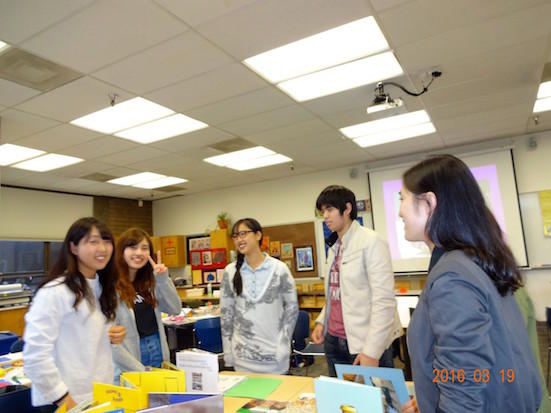
2016/03/19
講義の後半は、実際の子どもの遊びを体験しました。この写真の真ん中にいるのが、この夏に文京にやってきてふじみ野幼稚園で実習をするカブリヨのECE学生、ナンシーです。彼女は少し日本語が話せるようで、すでに学生たちと話が弾んでいました。今度は、文京の学生たちが彼女のサポートを日本でしてあげてください。これが双方向プログラムのいいところです。
The latter time of the lecture was spent for students to experience hands-on materials and look at some other displays such as homemade books made by children about their families and children’s portfolios. In this photo, Bunkyo students were with Nancy in the middle who visited us. Nancy is one of the Cabrillo ECE students selected to go to our university to do her internship this summer. They have a lot of things in common and help learn each other here and in Japan. That’s what our two-way programs aim for.
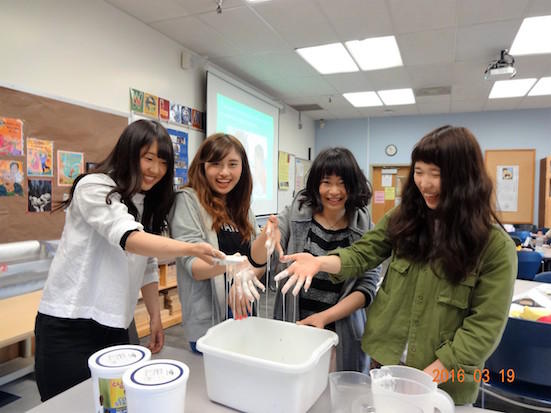
2016/03/19
コーンスターチと水でつくる「ウーブレック」(Oobleck)は不思議な物体です。液体と固体の間にあるもので、手で握って圧力をかけることで固体になり、それを放つと液体になって指から流れ落ちます。そんな物質のことを、”non-Newtonian”(非ニュートン液?)と呼ぶようです。なんだかとっても科学的ですね。とにかく、学生たちはその間の感触を楽しんでいるようです。
Oobleck is a mixture of cornstarch and water that can behave like a solid or a liquid depending on how much pressure you apply. Try to grab some in your hand and it will form a solid ball in your palm just until you release the pressure, then it will flow out between your fingers. Materials that behave this way are classified as non-Newtonian. That sounds very scientific! Anyway, these students were enjoying it.
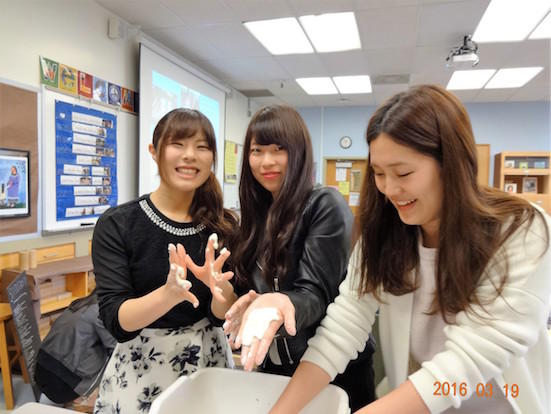
2016/03/19
こちらの学生たちも圧力のかけ方を変えて、握ってボールにしてみたり、手のひらに乗せたままにしていると、液体となって指から流れ落ちる感触を試していました。
These students squeezed Oobleck in their palm and it became tough ball. When they released it, it trickled down over their fingers. It was fun!
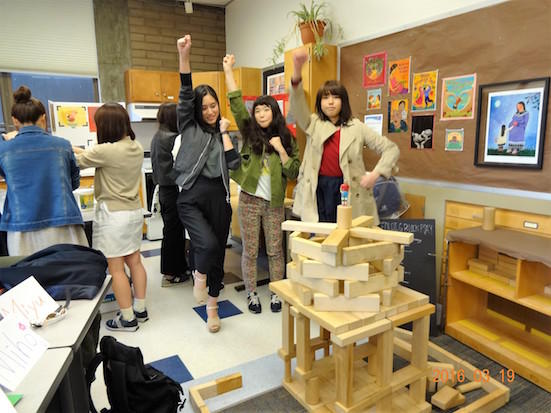
2016/03/19
こちらのグループは大きなブロックで遊んでいました。何を作ったのかはわかりませんが、本人たちは誇らしげです。かなり大きなものまでできるようです。
In this group, they built something with large wooden blocks. I was not sure what it was, but they look so proud of themselves, don’t they!
